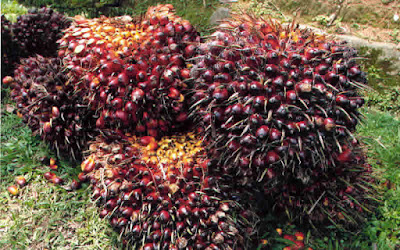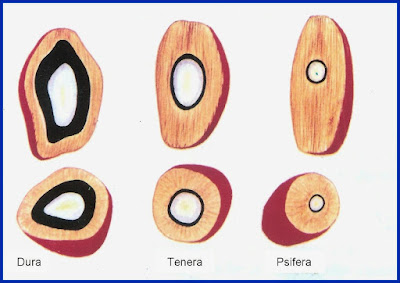 |
| Oil palms plantation |
About Oil Palm
The Oil Palm (Elaeis guineensis) originated in Africa, where groves of wild palms still exist. Cultivated varieties are now grown, however, on plantations in the equatorial tropics in South-east Asia and South America as well as in Africa.
Under favourable climatic conditions, the Oil Palm gives the highest yield of all the oil bearing plants. For best yields a rainfall of 80 inches or more per year is required with no very marked dry or wet seasons. The mean maximum temperature should be about 85 'F to 95 'F ( 29 'C to 32 'C ), and the mean minimum temperature about 72 'F to 75 'F ( 22 'C to 24 'C ).
At least 5 hours sunshine per day in all months of the year rising to 7 hours per day in some months is also needed for maximum yields. When this conditions met high yielding, oil palms have been found to give 10 to 12 tons of bunches per acre per year.
Read this article : History About Palm Oil
Read this article : History About Palm Oil
 |
| Palm seedlings |
Growth and Development
Under plantation conditions, the seeds (nuts) are allowed to germinate and then to grow into young plants in a nursery before being planted out in the fields.
The rate of growth is about 1,5 to 2,5 feet per year. And if allowed to, the palms could be expected to have a life of more than 100 years. In practice, due to falling yields and the increasing difficulty of harvesting the palms as they become taller, they are likely to be cut down and the area replanted after 25 years or so.
Bunch Formation and Fruit Types
As oil palms grow, new leaves (fronds) are produced, and the number of leaves produced annually by a plantation palm increases to between 30 and 40 shaft at 5 to 6 years of age. Thereafter, it declines to about 20 to 25 per annum.
In the axil of each leafs (i.e. where the leaf meets the stem) is a bud which may develop into a male or a female inflorescence, though some of these inflorescences abort before they emerge. The male and female inflorescence are distinct in appearance and both occur on the same palm.
Each inflorescence has a central stalk on which are arranged spirally a considerable number of spikelets ( of the order of 100 to 200 ) which carry the flowers.
An inner and an outer spathe (sheath) tightly enclose the inflorescence until about a month after it has fully emerged from the base of the petiole (i.e. leaf stalk). This about six weeks before the inflorescence is in full bloom (i.e. before anthesis).
Then the outer spathe begins to open and after a further 2 to 3 weeks the inner spathe splits. Later, both spathe fray and disintegrate and the inflorescence pushes through.
Read this article : Palm Kernel and Palm Kernel Oil
Read this article : Palm Kernel and Palm Kernel Oil
The Flowers of Oil Palm Tree
The numbers of flowers in a female inflorescence varies from palm to palm. But there is larger number (12 to 30 ) on the central spikelets than on the lower or upper spikelets. The female inflorescence will thus contain several thousand flowers.
On the spikelet of a male inflorescence there will be as many as 700 to 1.200 flowers. Usually all open within two days and shed pollen. About 25 to 50 grams of pollen is shed during 2 or 3 days following the start of production ceases within 5 days.
 |
| Female inflorescence |
After pollination, the female inflorescence develops into a fruit bunch, and it takes some few months after pollination for the bunch to become ripe. These individual fruits do not all become ripe at the same time. The ripening process may be spread over a period of about 15 days.
The fruits become detached or easily detachable when ripening, usually start on the part of the bunch which receives most exposure i.e. the top of bunch whereas the fruit nearer the point of attachment of the stalk to the palm ripen rather they receive less exposure.
The fruits are ovoid in shape varying in length about 2 cm to more than 5 cm and weight from 3 grams to over 30 grams. Botanically each consist normally of a single seed (the Kernel) surrounded by the Pericarp. The fruit includes three layers, viz : the hard Endocarp, the fleshy fibrous Mesocarp which contains Palm oil, and the thin external waxy skin named Exocarp.
In milling practice, it is normal to consider the fruit as consisting of a nut surrounded by "Mesocarp". The nut consists of the kernel within its shell (Endocarp), and the term "Pericarp" is to describe the Mesocarp and Exocarp combined. This point is mentioned to avoid confusion and to make it clear that when the term is used in connection with palm fruit processing.
Oil Palm Fruit types
Any particular oil palm will always produce bunches with fruit having one of three distinct usually recognisable forms. These form are known respectively as Dura, Tenera and Pisifera.
Dura
The nut of Dura form fruit has a relatively thick shell (between 3 and 8 mm thick). The percentage of Mesocarp to fruit is generally low to medium, 30% to 50%. Though in the particular case of Deli Dura, the Mesocarp may be as much as 65%. When cut transversely, no ring of fibres is noticed in the mesocarp close to the shell, and this is the way in which a Dura fruit may be distinguished from a Tenera.
Tenera
The nut of the Tenera form fruit usually has a thinner shell than the Dura. The shell thickness varies from 0,5 mm to 4 mm. However, so there is some overlap. The percentage of Mesocarp to fruit is generally medium to high, 60% to 90%. But may occasionally be as low as 55%.
When the fruit is cut transversely, a prominent ring of fibres can be seen close to shell and this provides the way of identifying a Tenera fruit.
Pisifera
The Pisifera form fruit has no Kernel or shell. It is composed almost entirely of fleshy oil bearing Mesocarp material.
Read this article : Palm Oil Production and The Nutrition for Health
 |
| Oil Palm Fruit bunchs |
Oil Palm Fruit Bunch
The weight of a ripe bunch of palm fruit i.e. of the central stalk with its spikelets and the individual fruits carried on these spikelets varies considerably, depending on the age and type of the palm and on the growing conditions. Thus, for example, at Kluang, in the years 1967, 1968 and 1969, the average weight per bunch was 10.2 kg, 11.8 kg and 13.2 kg, respectively.
Monthly average figures during this period varied over a wide range, viz from 8.1 kg to 16.2 kg. And the weight of individual bunches over a much wider range still. One bunch cut in september 1967, weighed as much as 80 kg. This was quite exceptionally large, but is mentioned as it gives some idea of the maximum size of bunch that may have to be dealt with occasionally by a factory.
At the other end of the scale are bunches from a plantation which has only been in bearing for 2 or 3 years such as Tungud, where the average weight per bunch in 1969 was only 5,6 kg.
You may also like this articles :
Social and Environmental Impact of Palm Oil
Roundtable on Sustainable Palm Oil / RSPO



Love the statistics you gave about the fresh fruit bunch. We usually see a different thing here in Nigeria. There are two types of palm trees we depend on for oil here
ReplyDeleteAgric and local, i don't really know the names, but the agric has more yield that the local.
but check out my site http://the-ahamefulas.com/palm-permutation/ for more details on it
What type of palm tree would grow best in Zambia and would be the expected yield per hectare? Under what conditions would we expect a yield of over 10 tonnes per hectare?
ReplyDelete